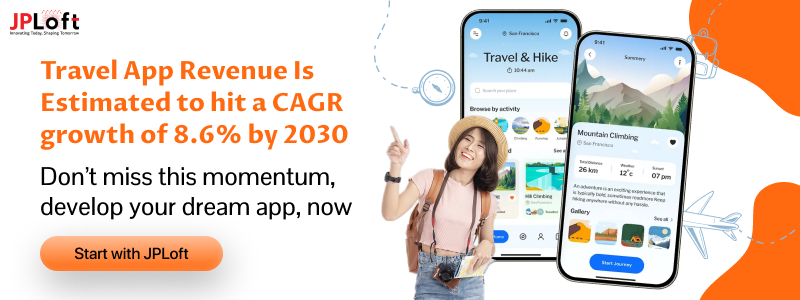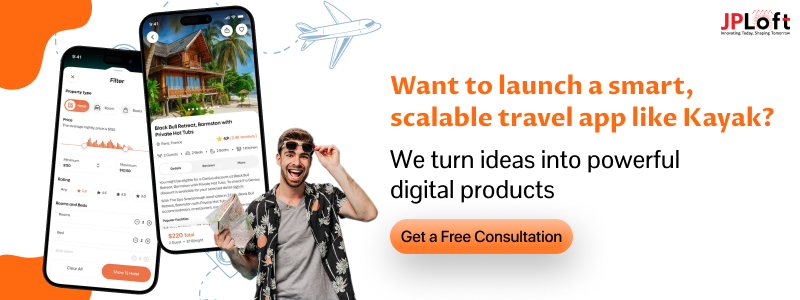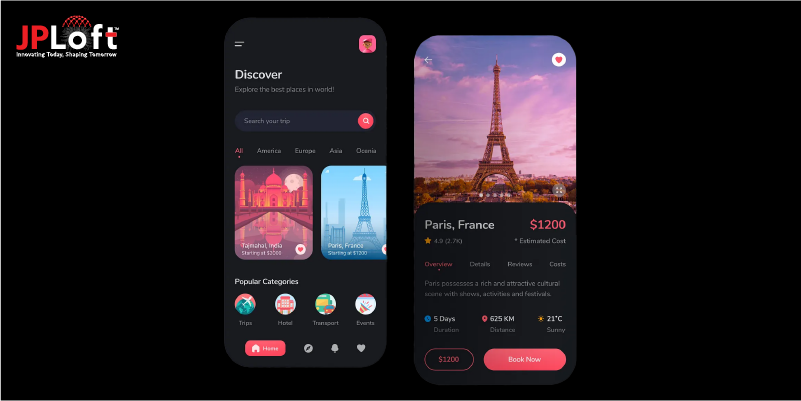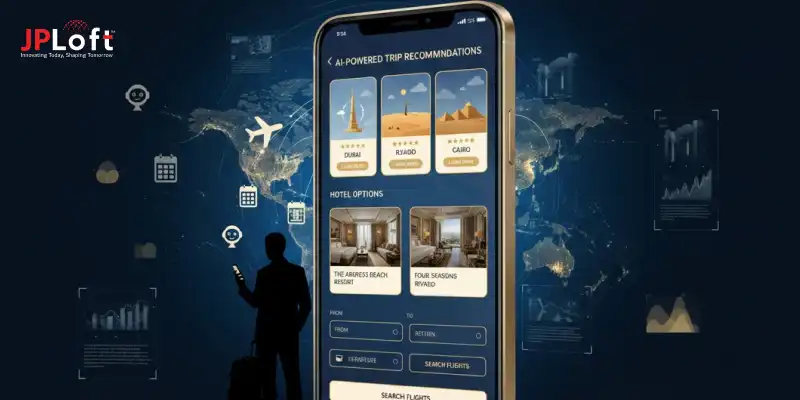Planning to Develop an App Like Kayak? Here’s Why It’s Worth It in 2025
“People don’t take trips—trips take people.” — John Steinbeck
In a world where spontaneous travel plans and last-minute bookings are the norm, users expect fast, intelligent, and personalized solutions. That’s exactly where apps like Kayak shine. As one of the most trusted platforms for booking flights, hotels, and rental cars, Kayak has reshaped how millions plan their journeys.
If you’ve ever wondered whether now is the right time to develop an app like Kayak, the short answer is: absolutely. With mobile-first travelers on the rise and the global travel tech market booming, launching a similar platform could put your business on the digital map.
In this blog, we’ll guide you through everything about Kayak’s model, features, development process, AI integration, cost, and how to build a winning monetization strategy.
Key Takeaways:
Apps like Kayak offer an all-in-one solution for booking flights, hotels, and car rentals.
To stand out, focus on real-time features, intuitive UI, and AI-driven personalization.
The cost to build an app like Kayak ranges from $35K to $200K+, based on complexity.
Multiple revenue models like affiliate commissions and subscriptions ensure profitability.
JPLoft’s expert team can help you build a scalable, user-friendly travel app from concept to launch.
Kayak Flights, Hotels, and Cars: A Brief Overview
Kayak is more than just a travel search engine; it’s a powerful all-in-one platform that helps users find, compare, and book flights, hotels, and rental cars across hundreds of providers. What sets it apart is its clean interface, intuitive filters, and real-time price tracking, all designed to make travel planning effortless.
1. Flights
Kayak’s flight search aggregates deals from airlines, OTAs (online travel agencies), and travel aggregators, presenting users with flexible filtering options for layovers, baggage, flight times, and price. It even includes tools like Price Forecasts to help travelers book smarter.
2. Hotels
Users can browse and compare stays across booking platforms like Booking.com, Agoda, Expedia, and more, all from one dashboard. The app includes map-based browsing, property reviews, and filters for amenities, guest ratings, and neighborhood.
3. Car Rentals
With partnerships across global rental agencies, Kayak’s car rental section makes it easy to find a ride that fits your budget and needs. From economy cars to SUVs, users can compare deals, view pickup/drop-off locations, and track rental conditions in real time.
This unified approach is what makes Kayak so appealing and why many travel brands are eager to make an app like Kayak or even develop a mobile app like Kayak to tap into this growing market.
Why Should You Develop an App Like Kayak in 2025?
As travel rebounds globally, user expectations are shifting from traditional websites to mobile-first, real-time platforms. Apps like Kayak lead the way by offering fast, convenient, and intelligent booking experiences.
But is it actually worth it to develop an app like Kayak in today’s market? Let’s look at what the numbers say.
Key Travel App Market Stats in 2025:
-
The global travel app market is projected to reach $2407.7 billion by 2034, growing at a CAGR of 14.8%.
-
70% of users now prefer using mobile apps to book flights, hotels, and car rentals.
-
Kayak’s mobile app has surpassed 55 million downloads worldwide, consistently ranking among the best travel apps in terms of user satisfaction and retention.
-
Mobile-first bookings accounted for over 52% of all travel transactions globally in 2024, and this number continues to grow.
These numbers paint a clear picture: travelers demand flexibility, speed, and personalisation, which Kayak nails through its simple interface and all-in-one model. Startups and travel businesses aiming to stay competitive are now investing in custom platforms that rival Kayak’s user experience.
However, the opportunity doesn’t come without its risks. Many ventures jump into the market with no clear differentiation or tech foundation, which is one reason why online travel apps fail. But if executed right, creating a powerful alternative or even choosing to develop a Kayak clone can be a highly scalable move.
Trends like AI integrations, AR-based navigation, and loyalty-driven travel apps are setting the stage for disruption. If you're thinking long-term, it might be time to build an online mobile app like Kayak, not just as a clone but as a smart, adaptive travel companion.
By aligning with current travel app development trends, you’ll be well-positioned to meet the future of mobile tourism head-on.
Essential Features to Build a Travel App Like Kayak
If you’re planning to build a travel app like Kayak, it’s crucial to understand what makes it so effective. Users love Kayak because of its seamless experience from searching flights to booking hotels and rental cars, all under one roof.
Below are the top travel app features you should consider when aiming to make an app like Kayak or even create a Kayak clone.
1] Advanced Search Filters
Users expect precision when looking for flights or hotels. Kayak’s multi-level filters let users narrow results by price, airline, layovers, time, ratings, and more, making it easier to book exactly what they need.
2] Real-Time Price Alerts and Forecasts
One of Kayak’s standout features is price tracking. It alerts users when flight or hotel prices drop and uses predictive analytics to forecast whether they should book now or wait.
3] Interactive Map-Based Search
A geolocation-based map view allows users to visually explore destinations, nearby hotels, or car pickup points. This makes discovery intuitive and fun.
4] AI-Powered Suggestions
The app uses machine learning to recommend hotels, cars, or flights based on previous searches, user behavior, and seasonal demand. This enhances personalization and user retention.
5] Multi-Mode Booking System
What makes Kayak powerful is that users can book flights, hotels, and rental cars within one app, eliminating the need for multiple platforms.
If you're exploring how to create an app like Omio that focuses on multi-modal transport, make sure your Kayak-like app includes real-time data syncing across buses, trains, and flights.
6] Trip History, Saved Itineraries & Loyalty Integration
Users can save trips, view booking history, and even apply reward points or loyalty memberships during checkout, making repeat bookings easier and more rewarding.
7] AR for Navigation and Exploration
Some travel apps are experimenting with AR to help travelers find restaurants, attractions, or hotels nearby by pointing their phones around them. If you're thinking long-term, integrating AR in travel apps can give your platform a futuristic edge.
Building an app with these core features is essential, but it's not without challenges. Ensuring smooth backend integration, securing third-party APIs, and offering real-time data updates are common travel app development challenges to be prepared for.
If you aim to match or exceed the experience of Kayak, aligning with these must-have features will ensure your product stands out in a competitive market.
How to Create an App Like Kayak: Step-by-Step Guide
So you’ve explored Kayak’s features and market potential; now it’s time to learn how to create an app like Kayak. Whether you're targeting local travel or global itineraries, the process involves strategic planning, tech execution, and strong user-focused design.
Many founders explore how to create an app like Hopper for its price prediction and travel flexibility but the process of building a Kayak-style platform shares a similar roadmap with added scalability features.
Here’s a step-by-step breakdown to help you build a Kayak clone or even create a more advanced travel app experience.
Step 1: Start with Market Research & Competitor Analysis
Before writing a single line of code, dive into the market. Who are your competitors? What gaps does Kayak miss? Analyze features, user reviews, and industry demand. This will help you define your unique value proposition and avoid mistakes that lead to failure.
Step 2: Outline Your App’s Core Features
Decide between building a Minimum Viable Product (MVP) or a full-fledged app. Essential features should include flight and hotel search, price tracking, user accounts, real-time filters, and bookings. This phase defines how you'll make a Kayak clone that aligns with user expectations.
Step 3: Choose the Right Technology Stack
Select platforms (iOS, Android, Web), front-end frameworks (React Native, Flutter), and back-end tools (Node.js, MongoDB, Firebase, etc.). Scalability and security should guide your choices.
Step 4: Focus on Clean UI/UX Design
A clean, intuitive interface can make or break your app. Travelers want fast, clutter-free booking experiences. Use visual cues like maps, icons, and smart filters. This is also where you'll bring your brand to life.
Step 5: Assemble the Right Team or Partner
Whether you’re outsourcing or building in-house, choosing the right tech partner is crucial. Many companies opt for top mobile app development companies in the USA to ensure quality, scalability, and compliance.
Step 6: Develop, Test & Integrate Third-Party APIs
Kayak works because of powerful integrations with booking engines, flight data providers, hotel inventories, and car rental APIs. You'll need solid backend support, payment gateways, and cross-platform testing.
It’s often beneficial to hire dedicated developers to manage third-party integrations, maintain scalability, and ensure reliable performance.
Step 7: Launch, Market, and Optimize
Once live, collect user feedback, fix bugs, and release updates. Growth will depend on performance marketing, referral programs, and customer retention strategies.
Entrepreneurs and even investors often ask, How to create a travel app?. The answer: build smarter, not bigger—focus on features that solve real traveler pain points.
If you're ready to create an app that rivals Kayak in function and experience, following this roadmap will put you on the right path. With the right blend of tech and travel logic, you can make a Kayak clone that truly stands out.
Use of AI in Creating an App Like Kayak: Features & Benefits
In today’s hyper-personalized travel economy, static filters and price listings aren’t enough. If you're aiming to make an app like Kayak, integrating Artificial Intelligence (AI) is no longer a luxury, it’s a competitive necessity. AI brings adaptability, intelligence, and predictive capabilities that transform a standard booking app into a personalized travel assistant.
Let’s explore how AI can elevate your platform if you’re planning to develop a mobile app like Kayak or develop an online app like Kayak that stands out in a crowded market.
► AI-Powered Personalization
AI analyzes user behavior, past searches, and preferences to deliver custom hotel, flight, and car rental suggestions. This not only improves user satisfaction but also boosts booking conversion rates.
► Dynamic Pricing and Fare Prediction
One of Kayak’s most loved features is fare forecasting. AI models predict whether flight prices will rise or drop based on historical trends, seasonality, and demand. Users can make smarter booking decisions, and you build trust.
► Smart Itinerary Planning
AI can compile optimal travel routes, suggest layover alternatives, or even recommend stay durations based on travel trends and user interests.
► Conversational AI & Chatbots
Instant, 24/7 travel support is expected today. AI-powered chatbots handle booking confirmations, cancellations, rebooking, FAQs, and even multilingual assistance without human involvement.
► Natural Language & Voice Search
Users can speak or type phrases like “cheapest flight to Bali next month” and get results instantly. AI interprets real human language, making the search experience effortless.
These features not only reduce friction but also allow you to build an AI app that adapts, learns, and grows with your users.
Partnering with the right AI app development company ensures you don’t just slap on smart features; you implement scalable intelligence that enhances every layer of the app.
And if you’re serving hotels or resorts alongside bookings, don’t ignore the impact of AI in hospitality. From dynamic room pricing to voice-activated check-ins, AI can personalize every guest’s journey.
In the end, if your goal is to develop an online app like Kayak that delivers future-ready travel experiences, integrating AI will give you a distinct competitive edge.
How Much Does It Cost to Build an App Like Kayak?
If you're planning to launch a full-featured booking platform, one of the first questions that comes to mind is: What’s the cost to build an app like Kayak? While there’s no one-size-fits-all answer, we can break it down based on features, platforms, technology, and development location.
On average, the Kayak app development cost can range between $35,000 and $200,000+, depending on complexity and scale.
The overall cost depends heavily on several factors, such as features, design, tech stack, and team location.
A] Feature Set
A basic MVP with search, filters, and booking might cost less than $50K, while an app with AI, AR, dynamic pricing, and third-party integrations can easily exceed $150K.
B] Platforms
Building for iOS and Android increases cost but expands reach. Cross-platform frameworks like Flutter can help optimize this.
C] Development Region
Hiring developers in North America or Western Europe costs significantly more than outsourcing to Asia or Eastern Europe.
D] UI/UX Design
A seamless, intuitive design is critical in travel apps and may account for 15–20% of your total budget.
E] Third-Party Integrations
APIs for flights, hotels, maps, and payment systems may have monthly fees and development costs.
F] Post-Launch Support
Ongoing updates, bug fixes, and customer support should be included in your long-term cost planning.
Don’t forget to allocate a budget for data privacy, GDPR compliance, and secure payments. Refer to a trusted travel app security guide to ensure nothing is overlooked.
If you aim to include AI or personalization features, the cost to develop a travel app will increase, but offer higher ROI. Apps similar in function and scale, like Agoda, have their own pricing structure. You can compare the cost to create an app like Agoda to benchmark decisions.
Likewise, if your platform also focuses on tourism content and immersive experiences, the cost to develop a travel app like Visit Dubai could be a better reference point.
Basic vs Advanced Build Comparison:
|
Build Type |
Estimated Cost |
Key Features |
|
MVP |
$35,000 – $60,000 |
Flight/hotel search, filters, booking, basic UI |
|
Mid-Tier |
$60,000 – $120,000 |
+ Price tracking, push alerts, loyalty features |
|
Enterprise |
$120,000 – $200,000+ |
+ AI, AR navigation, multilingual support, analytics dashboard |
The cost to make an app like Kayak will ultimately depend on your business model and the kind of experience you want to deliver. It's smart to start lean and scale fast.
How to Monetize an App Like Kayak: Proven Revenue Models
Building a powerful travel app is just one side of the coin; making it profitable is the other. If you’re wondering how to monetize an app like Kayak, you’ll be glad to know there are multiple ways to generate sustainable income, even without charging users directly.
Whether you're aiming to make an app like Kayak from scratch or build an online mobile app like Kayak for a niche audience, the monetization strategy you choose will define your long-term ROI.
1. Affiliate Commissions on Bookings
This is Kayak’s core model. When users book flights, hotels, or cars through your app, you earn a commission from affiliate partners or travel providers. It’s seamless and performance-based, meaning you only earn when your app delivers results.
2. Sponsored Listings & Featured Deals
Vendors pay to have their services (e.g., hotel stays or flight deals) featured at the top of search results. This pay-to-play model increases visibility for suppliers and adds a predictable revenue stream for you.
3. Premium Features or Ad-Free Subscriptions
Offer a free version with ads and a premium version with added perks like real-time fare tracking, itinerary exports, or offline access. Freemium apps are proven travel app monetization strategies that balance reach with revenue.
4. In-App Advertising
Integrate programmatic ads or native travel-related promotions. Ads can be geo-targeted, time-sensitive, or behaviour-based, helping you keep content relevant while monetizing traffic.
5. Subscription-Based Planning Tools
Consider offering curated travel plans, priority customer support, or multi-destination trip organizers behind a low-cost monthly or annual subscription.
6. B2B Solutions & API Licensing
Travel agencies or aggregators might pay to use your backend, search engine, or dynamic pricing tools through licensed access, especially if you specialize in a particular region or segment.
To execute these revenue models efficiently, it's a smart move to partner with the best mobile app development company that can help you set up the right monetization infrastructure from Day 1.
If your goal is to build an online mobile app like Kayak that sustains itself financially, choose a mix of 2–3 monetization streams that balance user value and business growth.
Partner with JPLoft to Build an App Like Kayak
Ready to turn your travel app idea into reality? At JPLoft, a travel app development company, we help businesses like yours build an app like Kayak from planning and design to launch and beyond.
With years of experience, our team delivers high-performance solutions that combine user-friendly design, real-time APIs, AI integrations, and scalable architecture. Whether you're looking to build a lightweight MVP or a full-featured global platform, we tailor every detail to your business needs.
Let’s collaborate to create a seamless, future-ready travel experience that users love and trust.
Conclusion
To succeed in today’s travel market, you need more than just a booking app. You need to develop an app like Kayak that delivers personalization, real-time data, and a seamless user experience. Whether you aim to make an app like Kayak from the ground up or build a travel app like Kayak tailored to a niche audience, the opportunity is massive. With the right tech stack and vision, your Kayak-style platform could be the next big name in digital travel.
FAQs
When you create an app like Kayak, it is important to look for the right steps starting from the market study, selection of features, build a tech stack, testing, launch and then end on maintenance.
Start by researching your target audience and defining your core features. Then, consult with an experienced development team to plan the tech stack, design, and API integrations needed to develop an app like Kayak.
Timelines vary by complexity. A basic MVP may take 3–4 months, while a full-scale platform with AI features can take 6–9 months or more to make an app like Kayak.
Depending on features, region, and platform, the cost to build an app like Kayak ranges from $35,000 to over $200,000.
Absolutely. Whether you're targeting solo travelers, luxury vacations, or corporate bookings, you can create a Kayak clone with custom features tailored to your niche.
Kayak stands out for its all-in-one booking model, predictive analytics, and user-friendly interface. Replicating these qualities is key when planning to develop an online app like Kayak.













Share this blog